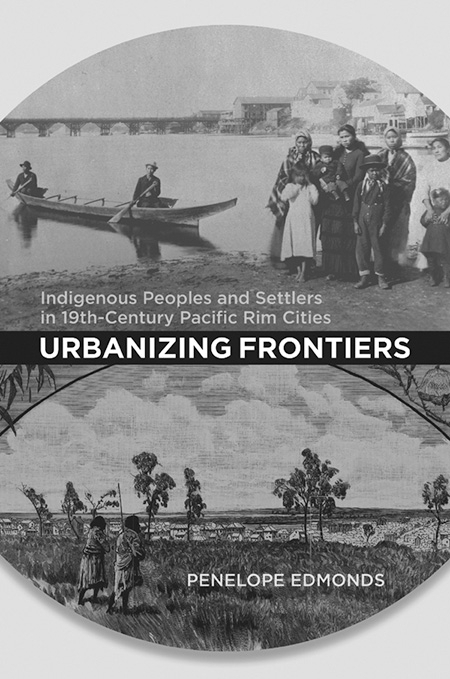Article body
In recent years, a growing number of historians have critiqued the bifurcation of urban and Indigenous histories. In Urbanizing Frontiers: Indigenous Peoples and Settlers in 19th-Century Pacific Rim Cities, Penelope Edmonds contributes to this literature through a comparative history of two colonial-settler cities: Melbourne, Australia, and Victoria, British Columbia.
Through comparative analysis Edmonds highlights the many points of divergence between these two colonial cities. In articulating the historical roots of such differences, she argues that “crucial departures lie in disparities between the economic and discursive formations that came to structure the respective colonies” (14). Unlike pastoralism in Australia, the fur trade economy of British Columbia depended on local Indigenous knowledge and labour. Such structural differences, she argues, led to the development of contrasting urban spaces in Melbourne and Victoria in the late nineteenth century. To illustrate this point, Edmonds opens her book by describing the differing streetscapes. In 1886, Franz Boas was fascinated by the many Indigenous people he met on the streets of Victoria, British Columbia. Two years later, and on another “edge of empire,” there were apparently “so few Aboriginal people in Melbourne that the director of the Melbourne Zoological Gardens placed Aboriginal people from distant Coranderrk Station on display in an ethnographic village as part of the Centennial exhibition” (3).
Interestingly, Edmonds’s research suggests such differences belie the vital colonial, historical, and geographical connections and similarities between nineteenth-century Melbourne and Victoria. She refutes the notion that these cities were built upon terra nullius, arguing instead that both occupied sites with rich Indigenous histories. While Melbourne was established on the lands of the Wurundjeri peoples, Victoria was founded on Lekwammen territory. Edmonds’s examination of urban indigeneity is methodologically impressive. After acknowledging her reliance on the colonial archive, she deftly reads archival sources against the grain to shed light on the imbrication of Indigenous and non-Indigenous peoples in the creation of urban space in each city.
In Urbanizing Frontiers, Edmonds makes an important contribution to the field of urban history by demonstrating that the colonial frontier, characterized by violence and conflict between settlers and Aboriginal peoples, existed not only in the “bush, backwoods, and borderlands,” but also in colonial cities (5). Through a theoretical framework influenced by scholars such as Anne Stoler, Frederick Cooper, Judith Butler, and Henri Lefebvre, Edmonds exposes the ways in which the “urbanizing frontier” was often an intimate place of “shared domestic and collaborative moments as well as sexual violence between Indigenous women and non-Indigenous men” (16). Yet, Edmonds’s nuanced historical analysis attends to the racial dynamics of urban space and she demonstrates that Melbourne and Victoria were not simply defined by the binary opposition of settlers and Aboriginals. In the eight chapters that make up the body of the work, Edmonds provides readers with rich urban histories that document the “tremendous tensions between the imagined bourgeois city and lived cities” of Melbourne and Victoria (135). Further, she rejects the notion of a break between the past and present and convincingly argues that it is important to “read the city as a continuing and vital structure of settler colonialism” (9). In her reflection on the contemporary relevance of these fraught histories, Edmonds offers a trenchant critique of the pervasive historiographical separation of Indigenous and urban histories.
The scope and dexterity of Edmonds’s historical analysis deserve acknowledgement. Completing this project for one city alone would have constituted a valuable contribution to the field of urban history. However, through her comparative analysis, Edmonds not only documents the related processes of change between Melbourne and Victoria but also sheds light on the operation of colonial power throughout the Pacific Rim in the nineteenth century. Yet, despite these achievements, some will disagree with several of Edmonds’s arguments and conclusions. Readers with an interest in Indigenous histories and geographies will be left wanting a more thorough examination of these topics. Her reliance on the colonial archive limits the book’s explication of Indigenous understandings of urban space in Melbourne and Victoria. Further, the argumentative narrative is at times disrupted by repetition. While this is related to the way in which Edmonds’s analysis moves between two cities, it is also a function of her theoretical framework, which requires a great deal of explanation and development throughout the book. Of course, these are minor criticisms that should not detract from the immense contribution Edmonds makes in Urbanizing Frontiers. Ultimately, this book indicates that there is much room for growth in the emergent field of scholarship that examines the entanglement of urban and Indigenous histories.



